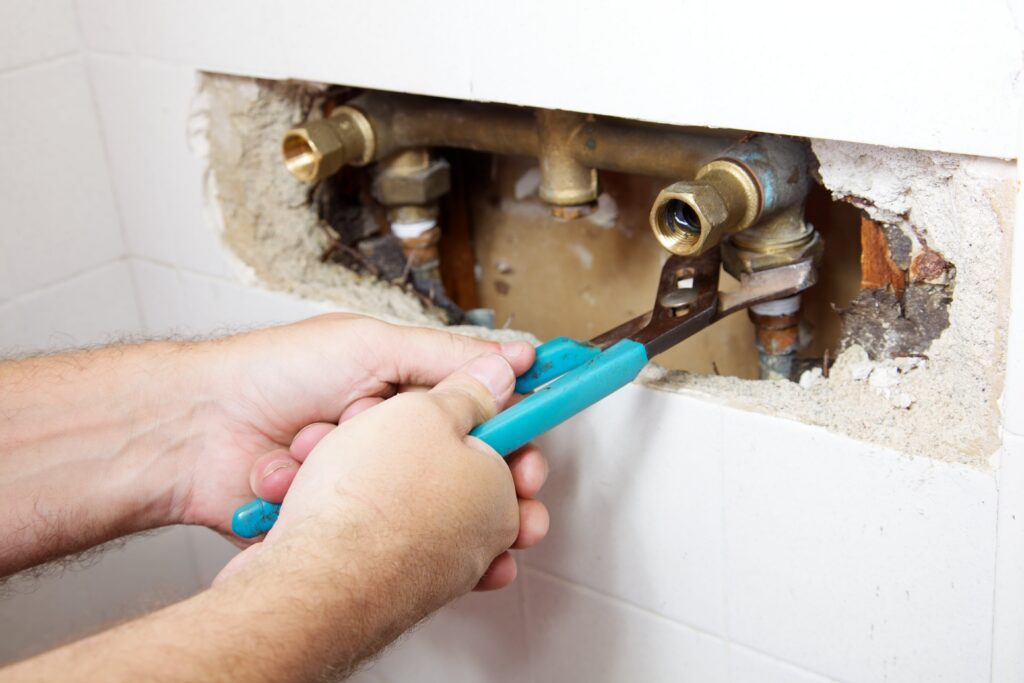Silencing Your Home’s Noisy Plumbing: Causes, Solutions, and Prevention
Have you ever been kept awake by the sound of water running through your home’s plumbing? Even the faintest of plumbing noises can become unbearable, especially in the middle of the night. These noises can range from annoying to concerning, but the good news is that they often have identifiable causes and practical solutions. In this comprehensive guide, we will explore the various types of noisy plumbing sounds, delve into their root causes, provide DIY solutions to silence them, discuss preventive measures, and offer guidance on when it’s best to seek professional help. Let’s dive in and ensure your home is a haven of peace and quiet.

Common Types of Noisy Plumbing
1. Hammering or Banging
Imagine the sound of a hammer striking your pipes—it’s known as water hammer. This deafening plumbing noise occurs when water suddenly slams into a closed valve or pipe when a faucet is turned off abruptly.
2. Vibrations or Humming
Vibrating, humming, or whining noises often emanate from your plumbing due to issues like improperly positioned isolation valves or excessive water pressure. These sounds can be irritating, especially if you’re trying to relax at home.
3. Rattling
Rattling noises, particularly when you turn a faucet on or off, are usually caused by unsecured pipes. As water flows through them, the pipes knock against walls or other parts of the building, creating a rattling noise.
4. Whistling or Squealing Noises
If you hear whistling or squealing coming from your plumbing, it’s typically due to worn washers. These tiny rubber components create a watertight seal, and when they wear out, they allow water to escape, causing high-pitched vibrations.
5. Rubbing or Ticking Noises
Expansion noises occur when hot water causes metal pipes to expand. As they grow in size, they may rub against walls, floors, or supporting clips, producing ticking, creaking, or rubbing noises.
6. Metallic Clinking Noises
This plumbing noise is often caused by mineral salt buildup within the pipes. If you’ve ever heard tiny pieces of gravel flowing through your pipes, it’s due to these solid mineral particles clinking against the walls of copper pipes.
Identifying the Causes
Understanding the root causes of these plumbing noises is essential for effective solutions:
- Loose Pipes: Loose or inadequately secured pipes can vibrate and produce noise when water flows through them.
- High Water Pressure: Excessive water pressure can lead to various plumbing noises, including water hammer and humming.
- Worn-Out Washers: Worn washers in faucets or valves can create whistling or squealing noises.
- Faulty Valves: If isolation valves or pressure-reducing valves are faulty, they can contribute to humming or whining noises.
- Unsecured Pipes: Pipes that are not properly secured during construction or have become loose over time can rattle.
- Mineral Buildup: Mineral deposits in the pipes can cause metallic clinking noises.
- Temperature-Related Expansion: As pipes heat up, they can expand and rub against surfaces, resulting in rubbing or ticking sounds.
DIY Solutions for Noisy Plumbing
Water Hammer
To fix water hammer, follow these steps:
- Drain the entire system to empty it of water.
- Turn off the main water supply valve for your house.
- Open all faucets to allow the water to drain out.
- Close the taps and reopen the main water valve to reintroduce air into the system.
If the problem persists, consider consulting a plumber to install water hammer arrestors for a long-term solution.
Vibrations, Humming, or Whining
To address vibrating, humming, or whining noises:
- Ensure isolation valves are fully open.
- Replace faulty isolation valves with new ones, if needed.
- Install a pressure-reducing valve if excessive water pressure is the cause.
If these steps don’t resolve the issue, consult a professional plumber.
Rattling
Fixing rattling pipes:
- Tighten or replace loose clips securing the pipes.
- Add additional fasteners to hold the pipes firmly in place.
For hidden pipes within walls, consider calling a plumber for assistance.
Whistling or Squealing Noises
To silence whistling or squealing noises, replace worn washers in faucets. If the problem persists, you may need to replace the entire faucet.
Rubbing or Ticking Noises
For expansion noises causing rubbing or ticking sounds:
- Replace clips that allow the pipes to rub against surfaces with isolating sleeves.
- Consider using “Mickey” clips made of polypropylene to support pipes below joists.
Metallic Clinking Noises
Prevent metallic clinking noises by using a chemical inhibitor that can be added to the water in the pipes. This inhibits mineral precipitation and keeps your pipes quiet.
Preventing Noisy Plumbing
Ensuring a peaceful and quiet home begins with proactive prevention. By taking steps to address potential issues before they arise, you can significantly reduce the likelihood of experiencing noisy plumbing. Here are some comprehensive strategies to prevent plumbing noises in your home:
1. Schedule Regular Maintenance Checks
Just as you would maintain your car to prevent breakdowns, your plumbing system also requires periodic checks. Regular maintenance inspections, conducted by a professional plumber, can identify and address potential plumbing issues before they become noisy disruptions. During these checks, plumbers can:
- Examine the condition of pipes, valves, and fixtures.
- Identify loose or damaged components.
- Check for signs of wear and tear.
- Assess water pressure levels.
- Evaluate the efficiency of water softeners and pressure-reducing valves.
By scheduling annual or bi-annual maintenance checks, you can catch and resolve minor plumbing problems early, preventing them from escalating into major disturbances.
2. Monitor Water Pressure
High water pressure is a common contributor to various plumbing noises, including water hammer and vibrations. Monitoring and regulating water pressure can help maintain a quieter plumbing system. Here’s how to do it:
- Invest in a water pressure gauge: Purchase a water pressure gauge from your local hardware store. These gauges are easy to install and can be attached to an outdoor faucet.
- Measure water pressure: Attach the gauge to a faucet and turn on the water supply. The gauge will display the water pressure in pounds per square inch (PSI).
- Check recommended levels: Research the recommended water pressure levels for your area, as they can vary. Generally, water pressure should be between 40 and 80 PSI.
- Install a pressure-reducing valve: If your water pressure consistently exceeds the recommended levels, consider installing a pressure-reducing valve. A plumber can help with the installation.
By maintaining appropriate water pressure levels, you can prevent excessive stress on your plumbing system, reducing the likelihood of noisy disruptions.
3. Consider Water Softeners
In areas with hard water, mineral deposits can accumulate in pipes over time, leading to metallic clinking noises. To mitigate this issue, consider installing a water softener. Water softeners work by removing minerals like calcium and magnesium from your water supply. By using soft water throughout your plumbing system, you can prevent mineral buildup and the associated noise.
Water softeners are available in various types, including salt-based and salt-free options.
Consult a plumber to determine the best water softener solution for your home based on water hardness levels and local water quality.
4. Secure Pipes During Construction or Renovation
If you’re planning construction or renovation work in your home, take proactive measures to ensure that pipes are properly secured. Unsecured pipes are more prone to rattling and vibrating when water flows through them, especially as temperatures fluctuate. Here are some tips:
- Work with experienced contractors: Collaborate with experienced contractors and plumbers who understand the importance of secure pipe installation.
- Use appropriate fasteners: Ensure that pipes are secured with suitable fasteners, brackets, or clips. The choice of fasteners should consider the material and diameter of the pipes.
- Insulate pipes: In areas where pipes pass through walls, floors, or ceilings, insulate them with materials designed to dampen vibrations and reduce contact with surfaces.
Properly secured pipes are less likely to generate disruptive noises, contributing to a quieter home environment.
When to Seek Professional Help
While DIY solutions can effectively address many plumbing issues, there are instances where it’s advisable to seek the expertise of a professional plumber. Understanding when to call in a professional can save you time, money, and potential damage. Here are some scenarios where professional help is recommended:
1. Complex or Severe Plumbing Issues
Complex plumbing problems, such as extensive pipe damage or major leaks, often require professional intervention. Attempting to address these issues without the necessary expertise can lead to further damage or costly repairs. Signs of complex plumbing issues may include:
- Water leaks or puddles in multiple areas.
- Decreased water pressure throughout your home.
- Persistent and severe plumbing noises that don’t subside.
- Foul odors or discolored water.
In such situations, contact a licensed plumber who can assess the problem accurately and provide a comprehensive solution.
2. Hidden Pipes Within Walls
When plumbing issues involve pipes hidden within walls, floors, or ceilings, they can be challenging to access and repair without causing significant damage. Attempting DIY repairs in these cases can result in costly structural damage and aesthetic issues. Signs of hidden pipe problems include:
- Mysterious leaks or water stains on walls.
- Unexplained water damage on ceilings or floors.
- Unreachable or inaccessible pipe sections.
To address plumbing problems involving hidden pipes, consult a professional plumber who can employ specialized equipment and techniques to diagnose and fix the issue with minimal disruption.
3. Persistent Problems Despite DIY Efforts
If you’ve attempted DIY solutions to address plumbing noises, but the problems persist or worsen, it’s a clear indication that professional expertise is needed. Repeated attempts to fix the issue on your own can lead to frustration and potential damage to your plumbing system. Don’t hesitate to call a licensed plumber who can conduct a thorough assessment, identify underlying issues, and provide a lasting solution.
While DIY efforts can resolve many plumbing noise issues, recognizing the limitations of your expertise is crucial. When faced with complex problems, hidden pipes, or persistent disruptions, entrusting the services of a professional plumber ensures that your plumbing system is restored to optimal functionality, guaranteeing a peaceful and noise-free home environment.
Ready to silence your noisy plumbing and enjoy a peaceful home? Contact Staggs Plumbing, your trusted plumbing experts serving the Dallas-Fort Worth area. Our experienced team is here to diagnose, repair, and prevent plumbing issues, ensuring a quiet and comfortable living environment. Call us today at 972-833-8660 to schedule a consultation and experience the tranquility your home deserves.


